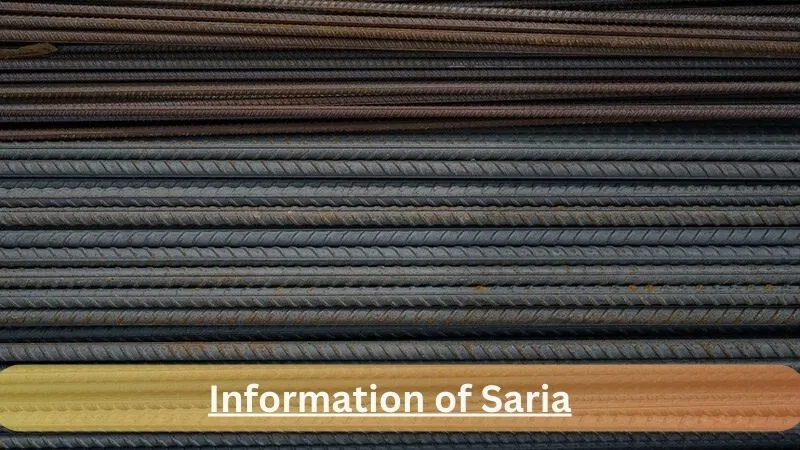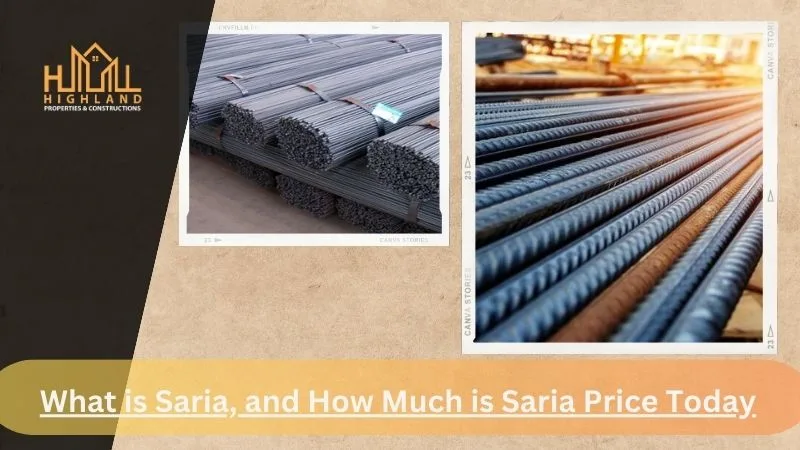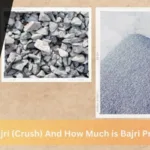Know Your Construction Materials: What is Saria, and How Much is Saria’s Price Today?
“Saria” is a word mainly used for steel reinforcement bars or reinforcement bars used in buildings. These bars are called “Rebars” in other parts of the world.
Reinforcing bars are made of steel. These are then used to make concrete stronger in tension. This is because concrete is weak in tension but strong in compression. You can only use steel as rebar because its thermal expansion rate is almost the same as that of concrete when stretching when it gets hot.
Information of Saria

Steel is often used to make Saria (rebar) because it has better tensile qualities than concrete. It is usually made from recycled steel from old cars, appliances and machines.
This steel is melted down in electric arc furnaces, cooled into billets, and stored. When the billets are ready to make rebar, they are heated to a high temperature (but not high enough to melt) and quickly run through extrusion tools.
The different steps of the extrusion process keep cutting the steel billet into rods with smaller and smaller diameters until the correct rebar diameter is reached.
A set of tools makes the deformations needed to keep the concrete from slipping. It is then cut to the length that is required.
Also Read: Know your construction materials: what is Bajri (Crush) and how much is Bajri price today
Saria Grades
There are two main types of grades for Saria:
· 40 Grades
· 60 Grades
Some people in Pakistan like saris made of 40-grade steel the most [Saria Price Today]. That being said, it is solid and sturdy but less intense than 60-grade steel. Steel in the 60th grade costs more than steel in the 40th grade, but it is more robust and lasts longer.
Saria Usage
Primary reinforcement
It is used to give resistance and support plan loads.
Secondary reinforcement
It makes something last longer and looks better by offering localized resistance to cracking and temperature-induced stresses.
Dividing the load
Spread out loads that are concentrating resistance over a larger area.
The right support
Help the other steel bars carry their weight by keeping them in the right place.
Renovation
External steel tie bars are used to support and tighten brick structures and sometimes to save old buildings.
Reinforced masonry
Some masonry bricks and blocks have spaces for rebar to hold up tension loads. Grout is used to hold the rebar in place.
Examples in Construction
Rebar is used in a lot of concrete buildings. Some common examples are:
· Lots of tall houses
· Ramps for parking
· Piers of concrete
· Buildings for bridges
· Lots of thick roads and garages, etc.
Saria Advantages
Following are some of the advantages of its usage for Saria (Rebars) in construction and its significance:
Structural strength
One of the best things about steel rebar is that it can hold a wide range of structures well. It is used in supports, bases, columns and wall panelling. Often, a single rebar will be joined to other rebars to make a framework that keeps it stable.
Although Rebar has a unique shape, it is suitable for adding power to concrete. The Rebar’s patterned and textured surface is designed to stick tightly to the concrete.
Once the material is fully set, the structure will be solid and able to handle any outside forces that might affect the whole building system because of the built-in rebar network.
With Rebar, concrete is several times less likely to break. You can get tensile strength from a corrosion-resistant strengthening bar.
Steel wires, reinforcing fibreglass, and many other goods on the market are less intense than Rebar in supporting concrete. It’s strong enough to hold up structures on its own.
Highly Malleable
By highly malleable, we mean when a material can resist breaking even after changing its appearance.
Since concrete is not very flexible, more is needed to support a building alone. Its material itself is fragile and easily breaks and cracks, especially when it’s exposed to different weather conditions. For instance, moisture can already make the gaps between the aggregates in concrete more extensive, which can result in breakdowns.
That is why Rebar is popular in concrete construction projects. Steel is very flexible, unlike concrete. Adding more carbon makes it more flexible and helps it stand up without breaking it. It can be bent and compressed accordingly.
Impact Resistant
A building needs to be able to protect itself from damage from impacts that can change how it looks and works. When mixed with other strong building materials, rebar is vital to making a building resistant to such effects.
A building must meet several compliance rules before being used per the requirement. As a result, it’s uncommon to see a concrete structure damaged immediately after taking a big hit.
This is why using multiple frames of rebars can make a building stronger against shaking during natural disasters like earthquakes. One clear example is how reinforced concrete can move heavy amounts of stress to other building parts.
Some building parts may fail or break, but the rebars’ ability to hold weight, bend, and add extra support and safety to the other parts persists.
Easy to assemble
Another good thing about rebar is that it is easy to put together in the right place for columns, foundation slabs, paving, drains and more. Rebars can be easily moved and set up in one place using materials easily.
Tying and welding are two common ways by which rebar frames are made. The contractors can check to see if their rebar can be used in either of these two ways. For instance, two rebars marked with “W” can be joined together.
Tying, on the other hand, is safer and more common. It only requires a few simple tools that you can find on any building site. For this reason, putting together tied rebars takes a lot less time and is considerably more accessible than any other methods involved.
Recyclable
Rebars are common and can be recycled many times without losing their features [Saria Price Today]. It can be a cost-effective choice. Think about all the buildings that have been torn down already. Many things that were used to build them, especially the rebar, can still be recovered.
Not only does the fact that rebar can be recycled cost money, but it also has environmental effects. When there is less trash, there is less work for dumps. Almost all rebars can be safely recycled and used again in a building, which cuts down on the amount of trash that ends up in landfills.
Types of Saria (Rebars)
There are different kinds of support bars (Saria) for buildings in Pakistan. Following are some of it below. All these types are different because of what they are made of, their strength, and many other factors involved. These are the most common types of saria:
· Mild Steel Bars (MS Bars)
· High Strength Deformed Bars (HSD Bars)
· Thermo-Mechanically Treated Bars (TMT Bars)
· Reinforcement bars (CRR Bars)
· Epoxy-Coated Reinforcement Bars
Mild Steel Bars (MS Bars)
These are plain carbon steel bars that don’t have a lot of carbon in them. They are often used for small to medium-sized building jobs.
The mild steel bars have a smooth, round surface. They come in sizes ranging from 6 mm to 50 mm. When bars need to slide in a metal or paper sleeve at an expansion joint, these are used as dowels in concrete.
They are also used for contraction joints in roads, airports, and column spirals. They don’t get damaged when you cut or bend them.
Grades of Mild Steel Bars
Different types of mild steel bars with different grades:
· Mild steel bars grade I or Grade 60.
· Mild steel bars of grade II or Grade 40.
High Strength Deformed Bars (HSD Bars)
The curved surface of these bars makes them stronger than mild steel bars in terms of tensile strength.
This is because the bars stick better to concrete. Many high-rise buildings, bridges, and other heavy-duty constructions use HSD bars.
Deformed steel bars have ribs, rings and depressions on their surface [Saria Price Today]. This makes it less likely for mild steel bars to slip. Because of this type, the concrete and rebar stick together well. It has better tensile qualities than other rebars. The diameter of these bars ranges from 6 mm to 50 mm.
Properties
Low carbon value: HSD bars have a low carbon content, which makes them strong, flexible, and easy to weld.
Better bonding power: HSD bars are famous for having excellent bonding power when used with concrete.
Welding ability: These bars can be welded 100% of the time, unlike regular bars, because they have less carbon.
Strong enough to tear apart: HSD bars are strong enough to tear apart. They are accommodating in the building process where bending and rebending are necessary.
Many different uses: These bars can be used to build many other things, like homes, businesses, factories, bridges and more.
Malleable: The material is sufficiently malleable, has the least weight, and is strong enough for compression and tension support.
Types
There are the following types of Deformed steel bars:
Thermo-Mechanically Treated Bars (TMT Bars)
To make TMT bars, a unique process has to be done that involves controlled heating and cooling. This process makes the saria more robust and more flexible. It doesn’t rust easily and is often used in earthquake-prone places.
Because of their high strength, these are used in reinforced cement concrete (RCC) work. The bars have better properties like:
· Stronger
· Flexible
· Easier to weld
· more accessible to bent.
· Better ability shape
· Very tough and high-yield strength
· More strength in bonds
· Resistance to earthquakes
· Resistance to corrosion
· High Resistance to heat
· Easy to use and saves money
· Normal wires were used to join the pieces together.
· It also meets the top quality standards at the international level.
Reinforcement bars that don’t rust (CRR bars)
These bars are carefully made not to rust, so they can be used in structures exposed to harsh weather or things that rust, like saltwater. They are often used in building projects on the water.
As the name suggests, these TMT bars are more resistant to rust. A small amount of chromium, copper and phosphorous is added to make the metal more rust-resistant.
These bars are the best choice when making dams, bridges or other structures near the coast.
Epoxy-Coated Reinforcement Bars
Epoxy is used to cover these bars to make them more rust-resistant. They are often used where rust is a big problem, like wastewater treatment plants and infrastructure along the coast.
It is a black rebar with a cement coat on it. It can hold the same tension but doesn’t only rust 70 to 1,700 times as quickly. However, the epoxy covering is very fragile. The covering is less resistant to corrosion when it is damaged.
Price of Saria
| Size in Sutar/mm | 40 Grade Rate in KG | 40 Grade Rate in Metric Ton | 60 Grade Rate in KG | 40 Grade Rate in Metric Ton |
|---|---|---|---|---|
| 3 sutar / 10mm | RS. 297 | RS. 297,000 | RS. 299 | RS. 299,000 |
| 4 sutar / 12mm | RS. 296 | RS. 296,000 | RS. 298 | RS. 298,000 |
| 5 sutar / 16mm | RS. 297 | RS. 297,000 | RS. 299 | RS. 299,000 |
| 6 sutar / 20mm | RS. 296 | RS. 296,000 | RS. 298 | RS. 298,000 |
| 7 sutar / 22mm | RS. 298 | RS. 298,000 | RS. 299 | RS. 299,000 |
| 8 sutar / 25mm | RS. 299 | RS. 299,000 | RS. 300 | RS. 300,000 |
List of Saria companies in Pakistan
Now that we have information about Saria prices in Pakistan, here is a list of top companies that manufacture high-quality iron rods or rebars for all construction projects.
· Pakistan Steel Mills
· Ittehad Steel
· Mughal Steel
· Amreli Steel
· Ittefaq Steel
· Kamran Steel
· AF Steel
· FF Steel
· Al Haj Asia Star Steel
Competency
A skill is the specific ability to do a job. Competence, on the other hand, means that a person knows how to do the task correctly. Knowledge, experience, attitude, personality, and physical skills are also parts of competence.
It’s hard to define and set the criteria for what “competency” means as subjective. But for starters, you need to compare the training someone has had with the jobs they will be doing or have done, as well as their knowledge and skills. In other words, their experience in the field.
For that, you can conduct market research, shortlist the names of the companies from which you wish to get quotations for your construction project and visit them.
But ensure that the team you hire is competent and uses your resources effectively. Be it just the Cement or otherwise.
Always go for a professional. Lucky for you, we are one.
Factors Affecting Saria Price in Pakistan
The price of saria in Pakistan is influenced by several key economic and industrial factors. Whether you’re tracking the iron saria price in Pakistan or planning a large-scale construction project, it’s essential to understand what drives daily price changes.
1. Raw Material Costs
One of the primary factors is the cost of raw materials, especially iron and scrap metal. Any increase in iron saria price in Pakistan directly impacts the overall saria rates across different grades and suppliers.
2. Dollar Exchange Rate
Pakistan’s steel industry depends significantly on imported raw materials. When the value of the dollar rises against the Pakistani rupee, the cost of importing materials increases, which causes a noticeable hike in the price of saria in Pakistan today.
3. Fuel and Energy Prices
Producing saria requires high amounts of fuel and electricity. As energy costs rise, so does the production cost. This results in an increase in construction saria price, especially for high-grade steel used in commercial and residential projects.
4. Demand and Supply Dynamics
When the construction industry experiences a surge in activity, the demand for saria increases. If supply does not meet demand, prices go up. Similarly, limited production or transportation issues can cause sudden spikes in saria price in Pakistan.
5. Government Policies and Taxes
Taxes such as customs duties and sales tax, as well as government regulations, also impact pricing. Any change in policy can instantly affect construction saria price, especially for bulk buyers and builders.
Our Services
Highland Properties and Constructions has a track record of giving excellent and unmatched construction project results over the past decade.
Our vision is about transparency, value generation, and exceeding our customer’s expectations in every manner that matters.
In addition to that, once we have someone on board, we are a team for them and have their back. Our cooperation and understanding go a long way with our clients. For more details, you can go through our portfolio. Also, here’s a link to what our clients say about us in the long run.
Summary
In this blog, we have discussed what saria is, its types, its usage, and top Pakistani companies, as well as why it is essential to know its relation to construction. In addition, we have also discussed how Highland Properties and Construction is a competent option for you if you want your construction project done using A-class material.
Saria Price Today-FAQ’s
Q1: What are some of the saria grades used in Pakistan?
A1: Grade 40 and Grade 60
Q2: What factors can affect the price of Saria to be used in Construction?
A2: The following factors can affect the price of saria in Pakistan:
· Brand
· Grade or quality that you want to buy rates for
· Production Raw Materials
· Costs of Energy
· Costs of Transportation and Carriage
· Cost of Labor
· High prices for gas and the dollar around the world
· The state of the local market
· Demand
· Supply etc
Q3: Why should I use Saria in my construction project?
A3: Saria must have been used in Construction during this era. In olden times, People lived in simple wooden homes. But now, with the changes in times, everyone wants the best house that is not only long-lasting but also shows strength in the face of any impact.





Leave a Reply